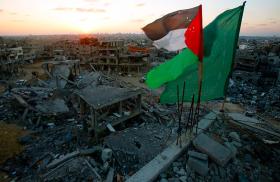
The Militia Assassination Surge (Part 1): Sabereen and Unit 10,000 Threaten Iraqi Forces

Both outlets are openly advocating the murder of Iraqi security forces at a time of escalated shootings and bombings.
On December 7, a motorcycle rigged with explosives killed four civilians in Basra. One day later, Prime Minister Mustafa al-Kadhimi visited the city and stated, "Yesterday’s [attack] was an assassination attempt against an officer in Basra because he was...investigating the Death Squad”—the Iraqi government's term for Iran-backed militia hit squads that target a wide range of activists and media figures they deem harmful to their interests. Muqtada al-Sadr likewise attributed the motorcycle bomb to “uncontrolled militias who misuse weapons under the pretext of resistance.” The attack was just one of several efforts to assassinate or threaten Iraqi security forces (ISF) this week. Part 1 of this analysis covers the rhetorical angle of these efforts; Part 2 details the December 7 attack and the broader pattern of killings.
Sabereen News Threatens Iraqi Intelligence Personnel
The new surge of militia attacks against the ISF began after the post-election protests and riots outside the International Zone (IZ). On November 5, individuals affiliated with the muqawama (resistance) tried to storm the IZ, which contains the government center. Clashes between these individuals and ISF units protecting the IZ led to the death of at least one protestor. The next day, a post by militia outlet Sabereen News threatened to kill the ISF members who were protecting the IZ that day: “We will make you pay the price. We will take revenge on you, one by one. You will live the rest of your lives looking over your shoulders in fear, and we will take revenge on you in the time and place you do not expect. Remember very well the suicide in Zafaraniyah, the kick in al-Adel neighborhood, and the Toyota of al-Baladiyat” (Figure 1). The message was deleted a few hours later.
The mention of "suicide in Zafaraniyah" refers to an alleged incident in which an officer working for the Iraqi National Intelligence Service (INIS) purportedly shot himself in his home in Baghdad’s Zafaraniyah neighborhood on November 9, 2020. Sabereen was hinting that this death was an assassination.
The "kick in al-Adel neighborhood" refers to the assassination of senior INIS officer Mahmoud Laith Mohammed Hussein, who was killed on March 21, 2021. The assassin approached the victim from behind, kicked him to the ground, and shot him dead (Figure 2). The incident reportedly happened in al-Mansour neighborhood of Baghdad, which is very close to al-Adel neighborhood.
Finally, the Toyota mention refers to the June 7 assassination of senior INIS officer Nibras Farman in al-Baladiyat neighborhood of Baghdad. The assassins used two Toyota pickup trucks with tinted windows and no plate numbers (Figure 3).
As Militia Spotlight has previously reported, muqawama militias like Asaib Ahl al-Haq and Kataib Hezbollah (KH) view INIS as their principal adversary in Iraq. Accordingly, they have fired rockets at the agency's sites and assassinated its personnel in an attempt to punish and intimidate Prime Minister Kadhimi, who doubles as the acting head of INIS.
Sabereen News and Unit 10,000 Expose Names of Security Personnel
Militia social media outlets also published the names of ISF members allegedly responsible for protecting the IZ on November 5. For example, Sabereen News threatened an intelligence officer involved in IZ security, putting his name in a post with the following sentence: “History will not be merciful. Prepare the gallows" (Figure 4). (The name was shown clearly in the original post, but Militia Spotlight has blurred it to protect his identity.)
Similarly, the KH-controlled outlet Unit 10,000 published the names of seventeen ISF members purportedly guarding the IZ. One such post named four ISF members responsible for Hummer vehicles on the scene (Figure 5) (Again, Militia Spotlight has blurred part of their names.)
Notably, Sabereen expressed disappointment with the lack of support from Iranian media organs during the November 5 riots, even though the channel itself is partly funded by Iran. And the previous month, Sabereen called for the beheading of Iraqi civilians in a Telegram post that (like the November 5 post discussed above) was later taken down—though not quickly enough to avoid being preserved as evidence. These incidents suggest that all is not well within the channel, as its Iranian funders struggle to keep the muqawama "on message" and operating within legal and Iraqi nationalist boundaries.
Indeed, Sabereen News and anyone who incites premeditated murder of government officials may be liable as accessories to the crime. Under the Iraqi penal code, punishments for accessories to a crime can be the same as for the principal. Those who fail to notify authorities of an offense may also bear legal liability, including financial penalties and detention.










